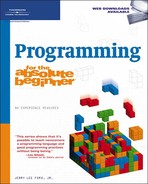In order to become an effective programmer with any programming language, you must dedicate yourself to learning the language through the development of new applications. This means that you have to spend time learning about and experimenting with different language features. As you learn more and tackle more challenging programming tasks, it helps to have a collection of source code from which you can draw and rely upon.
If you created each of the applications presented in this book as you went along, then you already have access to a good set of examples with which you can experiment and learn. However, in the event that you have not had time to create one or more of the book’s applications, you can download them from this book’s companion website located at www.courseptr.com/downloads.
Assuming that you have read each chapter of the book and that you did not skip around too much, then you should already have a good understanding of how each game works and what its purpose is. However, in case you jumped around a bit, I have provided you with a brief overview of each game in Table A.1.
Table A.1. Just BASIC Source Code Located on the Companion Website
Game | Description | |
|---|---|---|
Knock Knock Joke | This game provides an introduction to BASIC programming and demonstrates the steps involved in creating a small Just BASIC application that tells the player knock-knockjokes. | |
The Legend of Might Molly | This game demonstrates how to collect and process user input through the creation of a mad-lib style computer game. | |
BASIC Crazy 8 Ball | This game simulates a magic 8-ball that provides randomly selected answers to player questions. | |
Ask Mustafa | This game is based on the Austin Powers movie character Mustafa, who will not answer a question until he has been asked it three times in a row. | |
Rock, Paper, Scissors | This game demonstrates how to use conditional logic to create a player versus computer game based on the popular Rock, Paper, Scissors game. | |
Guess My Number | This game demonstrates how to use a loop to control the overall operation of a number guessing game. | |
BASIC BlackJack | This card game demonstrates how to improve the organization of BASIC applications through the use of functions and subroutines. | |
Tic Tac Toe | This is a two-player implementation of the classic Tic Tac Toe game. | |
Slot Machine | This game pits the player against a computer-simulated Las Vegas-style slot machine, complete with animation and sound effects. | |
Hangman | This game ties together all of the programming concepts demonstrated in this book through the development of a game that challenges the player to guess mystery words in six or fewer guesses. |
